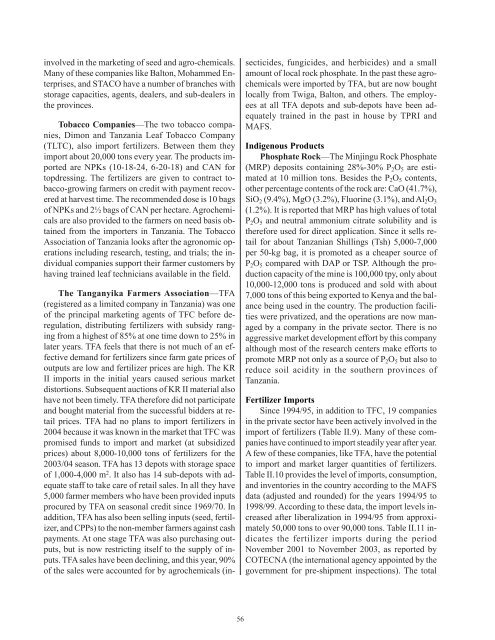An Action Plan for Developing Agricultural Input Markets in Tanzania
An Action Plan for Developing Agricultural Input Markets in Tanzania
An Action Plan for Developing Agricultural Input Markets in Tanzania
You also want an ePaper? Increase the reach of your titles
YUMPU automatically turns print PDFs into web optimized ePapers that Google loves.
<strong>in</strong>volved <strong>in</strong> the market<strong>in</strong>g of seed and agro-chemicals.<br />
Many of these companies like Balton, Mohammed Enterprises,<br />
and STACO have a number of branches with<br />
storage capacities, agents, dealers, and sub-dealers <strong>in</strong><br />
the prov<strong>in</strong>ces.<br />
Tobacco Companies—The two tobacco companies,<br />
Dimon and <strong>Tanzania</strong> Leaf Tobacco Company<br />
(TLTC), also import fertilizers. Between them they<br />
import about 20,000 tons every year. The products imported<br />
are NPKs (10-18-24, 6-20-18) and CAN <strong>for</strong><br />
topdress<strong>in</strong>g. The fertilizers are given to contract tobacco-grow<strong>in</strong>g<br />
farmers on credit with payment recovered<br />
at harvest time. The recommended dose is 10 bags<br />
of NPKs and 2½ bags of CAN per hectare. Agrochemicals<br />
are also provided to the farmers on need basis obta<strong>in</strong>ed<br />
from the importers <strong>in</strong> <strong>Tanzania</strong>. The Tobacco<br />
Association of <strong>Tanzania</strong> looks after the agronomic operations<br />
<strong>in</strong>clud<strong>in</strong>g research, test<strong>in</strong>g, and trials; the <strong>in</strong>dividual<br />
companies support their farmer customers by<br />
hav<strong>in</strong>g tra<strong>in</strong>ed leaf technicians available <strong>in</strong> the field.<br />
The Tanganyika Farmers Association—TFA<br />
(registered as a limited company <strong>in</strong> <strong>Tanzania</strong>) was one<br />
of the pr<strong>in</strong>cipal market<strong>in</strong>g agents of TFC be<strong>for</strong>e deregulation,<br />
distribut<strong>in</strong>g fertilizers with subsidy rang<strong>in</strong>g<br />
from a highest of 85% at one time down to 25% <strong>in</strong><br />
later years. TFA feels that there is not much of an effective<br />
demand <strong>for</strong> fertilizers s<strong>in</strong>ce farm gate prices of<br />
outputs are low and fertilizer prices are high. The KR<br />
II imports <strong>in</strong> the <strong>in</strong>itial years caused serious market<br />
distortions. Subsequent auctions of KR II material also<br />
have not been timely. TFA there<strong>for</strong>e did not participate<br />
and bought material from the successful bidders at retail<br />
prices. TFA had no plans to import fertilizers <strong>in</strong><br />
2004 because it was known <strong>in</strong> the market that TFC was<br />
promised funds to import and market (at subsidized<br />
prices) about 8,000-10,000 tons of fertilizers <strong>for</strong> the<br />
2003/04 season. TFA has 13 depots with storage space<br />
of 1,000-4,000 m 2 . It also has 14 sub-depots with adequate<br />
staff to take care of retail sales. In all they have<br />
5,000 farmer members who have been provided <strong>in</strong>puts<br />
procured by TFA on seasonal credit s<strong>in</strong>ce 1969/70. In<br />
addition, TFA has also been sell<strong>in</strong>g <strong>in</strong>puts (seed, fertilizer,<br />
and CPPs) to the non-member farmers aga<strong>in</strong>st cash<br />
payments. At one stage TFA was also purchas<strong>in</strong>g outputs,<br />
but is now restrict<strong>in</strong>g itself to the supply of <strong>in</strong>puts.<br />
TFA sales have been decl<strong>in</strong><strong>in</strong>g, and this year, 90%<br />
of the sales were accounted <strong>for</strong> by agrochemicals (<strong>in</strong>-<br />
56<br />
secticides, fungicides, and herbicides) and a small<br />
amount of local rock phosphate. In the past these agrochemicals<br />
were imported by TFA, but are now bought<br />
locally from Twiga, Balton, and others. The employees<br />
at all TFA depots and sub-depots have been adequately<br />
tra<strong>in</strong>ed <strong>in</strong> the past <strong>in</strong> house by TPRI and<br />
MAFS.<br />
Indigenous Products<br />
Phosphate Rock—The M<strong>in</strong>j<strong>in</strong>gu Rock Phosphate<br />
(MRP) deposits conta<strong>in</strong><strong>in</strong>g 28%-30% P2O5 are estimated<br />
at 10 million tons. Besides the P2O5 contents,<br />
other percentage contents of the rock are: CaO (41.7%),<br />
SiO2 (9.4%), MgO (3.2%), Fluor<strong>in</strong>e (3.1%), and Al2O3<br />
(1.2%). It is reported that MRP has high values of total<br />
P2O5 and neutral ammonium citrate solubility and is<br />
there<strong>for</strong>e used <strong>for</strong> direct application. S<strong>in</strong>ce it sells retail<br />
<strong>for</strong> about <strong>Tanzania</strong>n Shill<strong>in</strong>gs (Tsh) 5,000-7,000<br />
per 50-kg bag, it is promoted as a cheaper source of<br />
P2O5 compared with DAP or TSP. Although the production<br />
capacity of the m<strong>in</strong>e is 100,000 tpy, only about<br />
10,000-12,000 tons is produced and sold with about<br />
7,000 tons of this be<strong>in</strong>g exported to Kenya and the balance<br />
be<strong>in</strong>g used <strong>in</strong> the country. The production facilities<br />
were privatized, and the operations are now managed<br />
by a company <strong>in</strong> the private sector. There is no<br />
aggressive market development ef<strong>for</strong>t by this company<br />
although most of the research centers make ef<strong>for</strong>ts to<br />
promote MRP not only as a source of P2O5 but also to<br />
reduce soil acidity <strong>in</strong> the southern prov<strong>in</strong>ces of<br />
<strong>Tanzania</strong>.<br />
Fertilizer Imports<br />
S<strong>in</strong>ce 1994/95, <strong>in</strong> addition to TFC, 19 companies<br />
<strong>in</strong> the private sector have been actively <strong>in</strong>volved <strong>in</strong> the<br />
import of fertilizers (Table II.9). Many of these companies<br />
have cont<strong>in</strong>ued to import steadily year after year.<br />
A few of these companies, like TFA, have the potential<br />
to import and market larger quantities of fertilizers.<br />
Table II.10 provides the level of imports, consumption,<br />
and <strong>in</strong>ventories <strong>in</strong> the country accord<strong>in</strong>g to the MAFS<br />
data (adjusted and rounded) <strong>for</strong> the years 1994/95 to<br />
1998/99. Accord<strong>in</strong>g to these data, the import levels <strong>in</strong>creased<br />
after liberalization <strong>in</strong> 1994/95 from approximately<br />
50,000 tons to over 90,000 tons. Table II.11 <strong>in</strong>dicates<br />
the fertilizer imports dur<strong>in</strong>g the period<br />
November 2001 to November 2003, as reported by<br />
COTECNA (the <strong>in</strong>ternational agency appo<strong>in</strong>ted by the<br />
government <strong>for</strong> pre-shipment <strong>in</strong>spections). The total

















